Inside the website, there are TWO highlights and FIVE sub-sites for data input and retrieval:

1. Latest news – Visits highlights
a) Location highlights - top ten most recent visits submitted. Information on Location, last visited date and observer.
b) Species Highlights - top twenty most recent rare or unusual bird observations (highly sensitive records are excluded). Information on Species, location, visit date, observer
2. My visits – the sub-site to enter your sighting. The fields of data are:
a) Location* - type in key word of the location, select from a pull down menu of a list of locations. If your visit site is not listed, please enter new location information in “My Location” sub-site. The Validation Team will validate the site detail before acceptance.
b) Date*
c) Duration Time : start to end time
d) Actual time spent birding * Hrs Mins
e) Enter the number of observers
f) Did you record all birds seen/heard? Tick the box if yes
g) Were no birds seen? Tick the box if yes
h) Species name* - pull down list of the Malaysian Checklist. If you saw a new species, you can type "New Country Species" then [Tab]; then enter the detail in the notes section. You will still be required to submit a new record form to the Records Committee.
i) Did weather, visibility, disturbance etc affect your counts? Tick the box if Yes.
j) Purpose (if for a particular project) eg. MNS Bird Group visit, MNS expedition
k) Other notes for the visit – indicate weather situation that has an effect on your visit, habitat and vegetation status, other observer’s name (only for those not a registered user of the system).
l) Who did you go with – Click the question to submit other observer’s name here, this applies only if they are also a registered user of the system. Type a word and a pull down list for you to choose from. This will make your visit information available to other registered users by adding their user name here.
m) Total species observed during visit - You can enter data simply as a list of species, or associate further information with each observation. The more information collected, the more useful the record is.
Please indicate the plumage, behaviour, whether it’s breeding; whenever you feel of importance. If there is a sub-species or various morphs, please also indicate.
You can enter the number of birds seen or zero to indicate that you looked for a species but did not see/hear it (a null count).
For presence only, leave the count field blank.You can mark observations as being only available to yourself and other registered users associated with this visit by ticking the private box. However, we strongly urge you to avoid using this facility as one of our guiding principles is open access to data for everyone. Locations of highly sensitive species are automatically obscured.
* indicates mandatory fields
3. My Locations – enter a new location not listed in the database. Please collect as much information on the location as possible – is it under an IBA site; GIS information and GPS co-ordinates; site name and address; site size; land use type by % (agriculture, ex-mining, reserve, etc). Latitude and longititude co-ordinates are mandory fields, can you obtain them from the map or google earth function. If you still do not manage to get the co-ordinates, enter 1 to both fields.
4. Reports – to generate analysis of the database. You can also obtain information on all IBA sites. Maps are also available for certain locations.
a) Location report - a full list of observations at a location.
b) Location summary report - a summary of species recorded at a location
c) Location summary report, full checklists - a summary of species recorded at a location, full checklists only.
d) Species report - a full list of observations for a species.
e) Species summary report - a summary of locations where a species has been seen.
f) Coverage: All data - map of all locations visited
g) Coverage current year – map of locations visited current year
5. Species Checklist
a) Country checklist - a checklist for all species in the country.
b) My country checklist - a checklist for all species you have recorded.
c) A checklist for all species you have not yet recorded
d) Location checklist - a checklist of species associated with one or more locations, based wholly on existing data
6. Top 50 List
a) Top 50 locations - 50 locations with the most visits
b) Top 50 species - 50 species with the most observations
c) Top 50 users - 50 users with the most visits to locations
d) Top 50 observations - 50 users with the most observations of species
7. My Details – to change personal details. You can also change your species name display option: Malaysia common name, Scientific name or Birdlife common name.
8. At top bar, there’s an option to work offline. You will need to download the software first. You will be able to add bird data, but sites must already exist in the on-line version and cannot be added or edited off-line.



.gif)